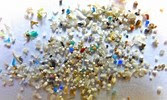Microbeads are tiny spherical particles
often found in various healthcare and beauty products such as toothpaste,
facial cleansers, and body wash. While these beads are used for exfoliation and
polishing for the purpose of you being cleaner, it however is not the same for
the environment. It may seem like insignificant issue because microbeads are
tiny (usually smaller than 2 millimeters), however they are not degradable.
This makes them easy to wash down the drain without causing plumbing issues; but
they do not get filtered during water treatment.
Microbeads absorb other toxic
pollutants such as pesticide and motor oil. If a single microbead can contain
so many other toxic materials, imagine the impact of hundreds and thousands of
them washing through watering systems. Consumption of it endangers wildlife
(such as fish, and other animals that eat fish and drink water from streams). When
we consume these animals, we are essentially digesting plastic (and who knows
what it absorbed) as well. This creates a cycle that greatly affects wildlife
as well as us.
It is because they are long-lasting
and cheaply manufactured, that they are favored by many cosmetic brands, versus
opting for bio-degradable plastics which require a larger scale facility to
create. Microbeads are smooth and non-abrasive, and take a while to actually exfoliate
the skin, which then causes consumers to purchase the product more often and
drive up sales. However there are many campaigns and organizations fighting
against it (and many states and countries trying to ban it):
- Beat the Microbead (http://www.beatthemicrobead.org/en)
- World Oceans Day (http://www.worldoceansday.org/help-us-beat-the-microbead/)
- Perseus (http://www.perseus-net.eu/site/content.php?locale=1&sel=419&artid=405)







